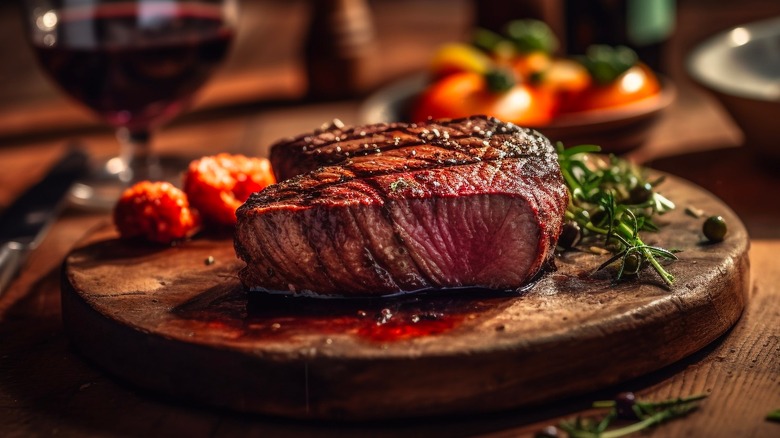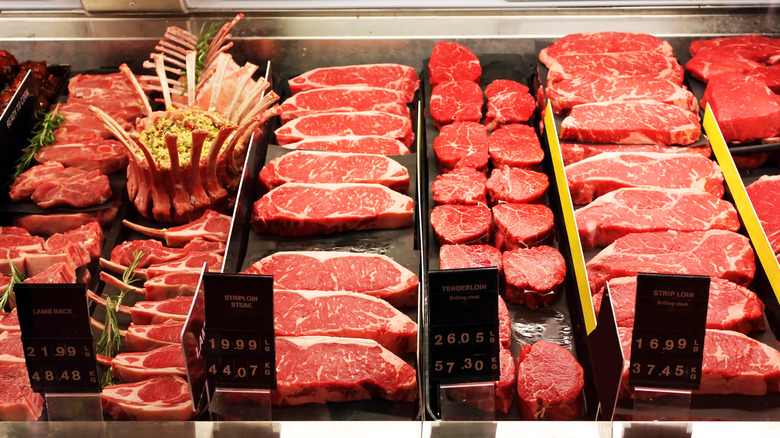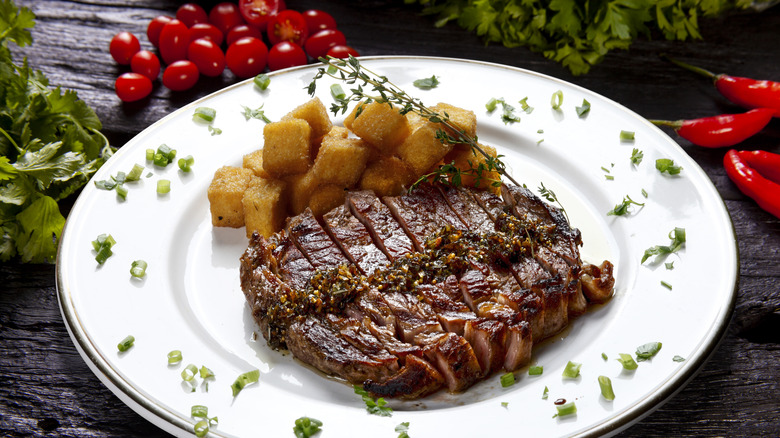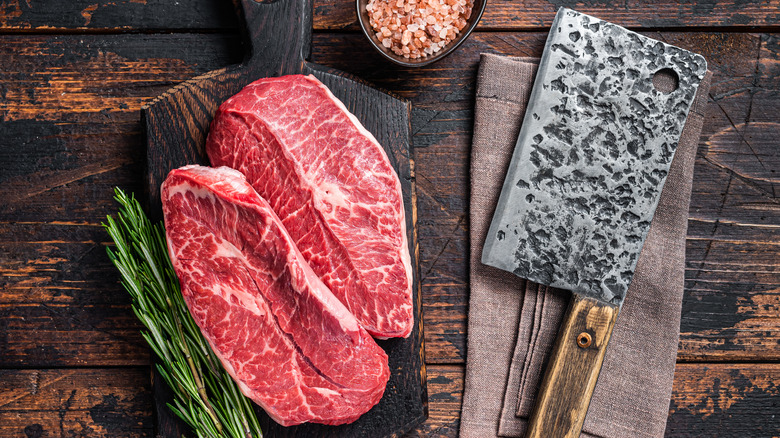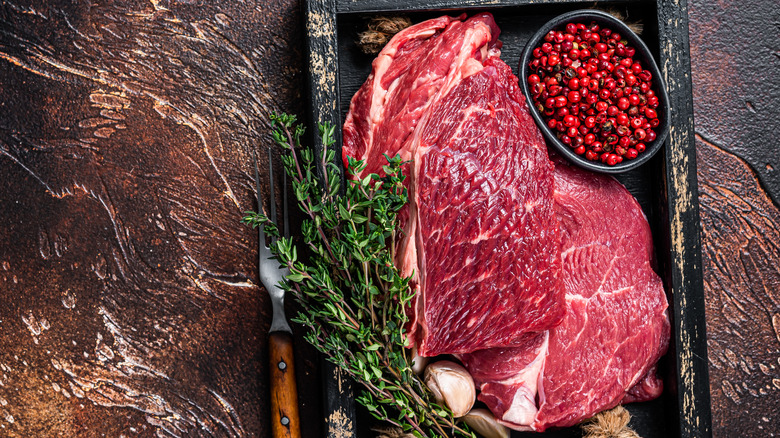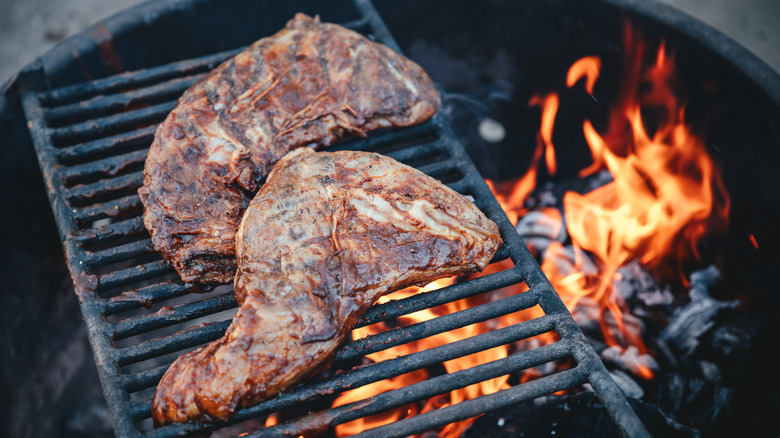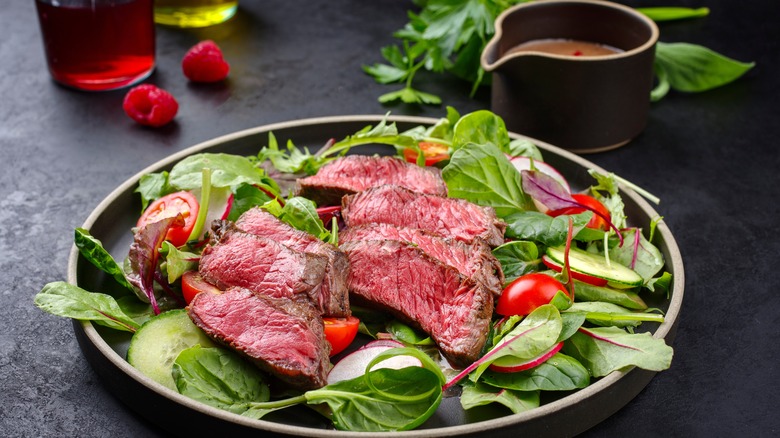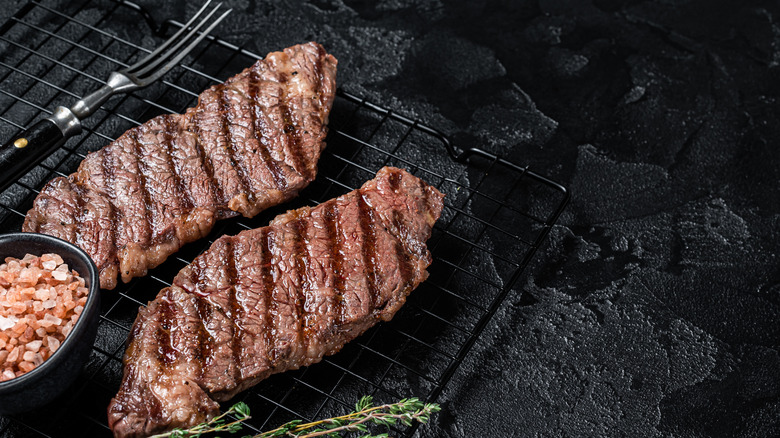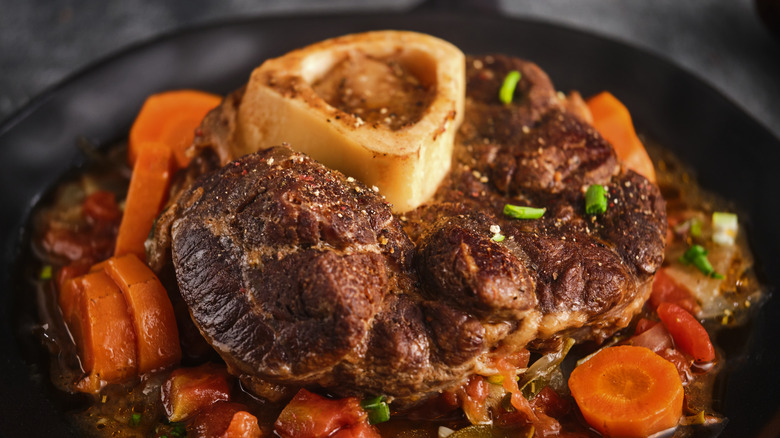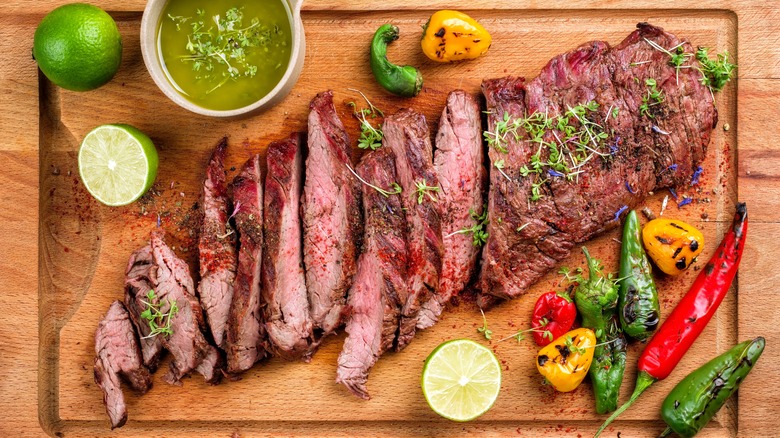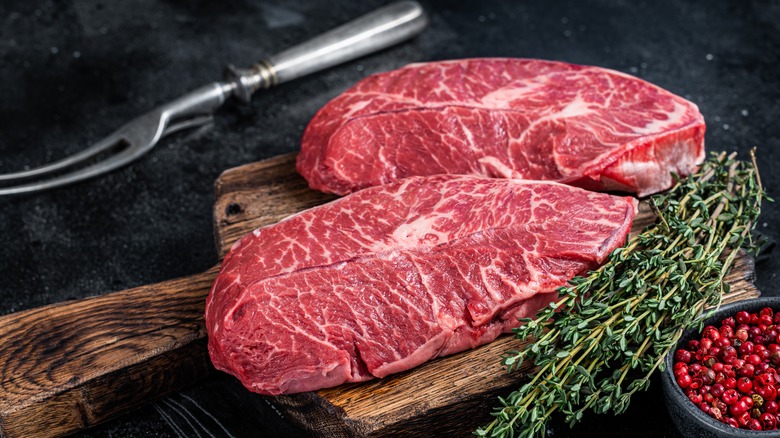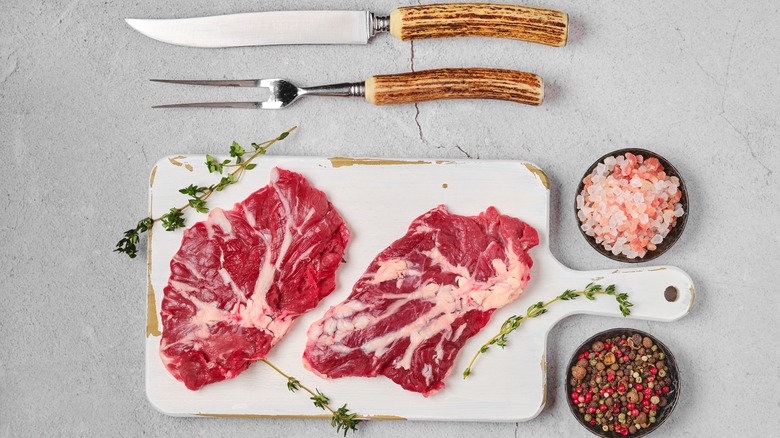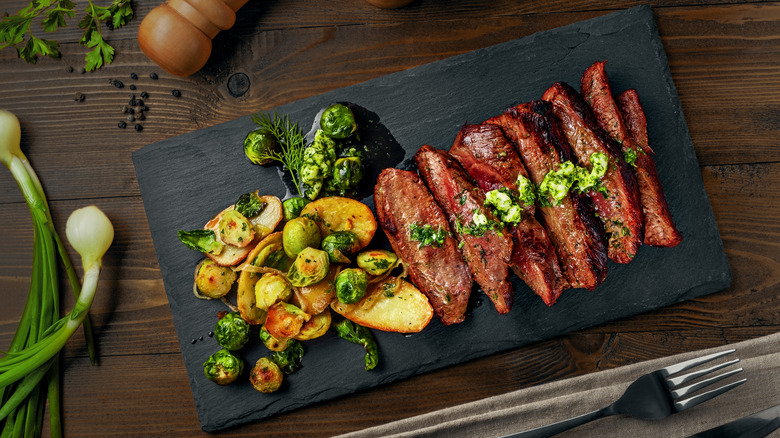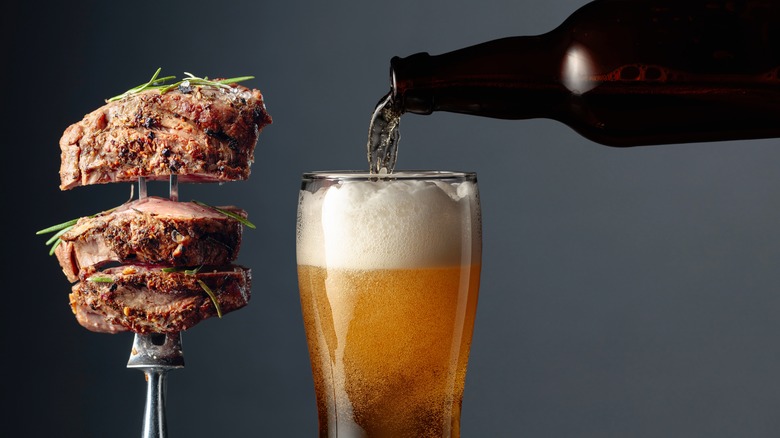Flavorful Steak Cuts That Won't Break The Bank
With grocery prices steadily rising, finding quality cuts of meat can be challenging, especially if you do not want to spend a small fortune on a couple of steaks. Likewise, figuring out which cut is best for a particular recipe or which kind of steak will give you the most bang for your buck is not easy to do on the spot either. Still, most butcher shops and grocery store meat counters offer quite an array of beef cuts.
Yet, there are only eight primal cuts of beef (or eight main sections). So here is where things get a little tricky — each section is further broken down, resulting in several steak options. The exception to this rule, however, is the flank, also known as the London broil (since it is a city favorite, you can get practically anywhere in the Big Smoke). Flank steak is the only primal cut that comes from a cow's abdominal muscle and is considered lean, long, flavorsome, and relatively affordable. That said, there are more than a few other flavorful steak cuts that won't break the bank — you just need to know what to look for.
Enjoy a flavorful steak at any price point
Before digging into the most reasonably priced steaks, it is important to know that you can enhance the flavor of virtually any cut of meat with a few tips and tricks. Something as simple as opting for the suggested cooking method for your beef filet or using a cast-iron skillet drastically improves the taste of your steak. Avoiding over-seasoning your meat and just sticking to a generous pre-cook sprinkle of kosher salt is another way to keep your steak's natural savoriness.
Using rosemary and garlic will also help to intensify your chosen cuts overall taste. Of course, you can still use a nice steak rub. But it is highly recommended that you make your own rub if you decide to go this route — so you are in charge of the salt or MSG levels. Other flavor game-changers for your steak include a homemade compound butter, a good marinade, or a tried-and-true Worcestershire sauce, balsamic vinaigrette, and ground mustard soak. However, it is worth noting marinades work best with a high-fat content cut of meat.
Flank or skirt steak doesn't disappoint
As briefly mentioned, flank steak is an inexpensive cut of meat you can get for somewhere between $14 to $29 per pound. Though this cut is tougher than most, you can still get a nice texture and incredible taste, especially when cooked to rare or medium rare. Here, grilling or pan-searing will produce the best-tasting steak with minimal seasoning. You can also oven broil this particular cut after tenderizing.
On the other hand, skirt steak is often interchangeable with flank steak and usually costs $10.99 per pound. Skirt steak is classified as a fattier cut of meat from the lower rib or diaphragm area and can be found in two variations — inside and outside skirt. Most stores carry both, but if you want a more succulent steak with top-notch marbling, then try to get outside skirt. As a whole, skirt steak is rich in flavor and low in price. This buttery and bold beef option can be marinated to perfection and quickly cooked over high heat via the grill or a searing hot cast iron pan.
Shoulder steak is for beef lovers
Shoulder steak is another affordable choice that comes from the neck area of the cow or the square-cut chuck primal. Depending on whether you are looking at thinly sliced steaks or thicker shoulder roasts, you can expect to pay as low as $5.99 per pound. for this crowd-pleaser. Revered for its juicy beef flavor, shoulder steak is actually one of the better chuck cuts you can buy for less. Flavorful and economical, this beefsteak is ideal for grilling and pan-searing.
Usually, the deciding factor for which cooking method is the better choice depends on whether you have access to a grill. A popular option when opting for shoulder steak, grilling brings out the natural and palatially beefy undertones of this cut while simultaneously adding a smoky finish. Thus, extra seasoning or marinades are not a requirement here. If you do not have access to a grill, however, then the next best thing is pan-searing — just properly prep your meat for this method, and remember your steaks should be at room temperature before searing for even cooking and to lock in all that flavor.
Chuck eye steak delivers intense flavor
Yet another affordable cut of steak is the Delmonico or the chuck eye steak, sometimes even referred to as the poor man's ribeye. This cost-conscious cut is, unsurprisingly, for beef ribeye lovers on a budget. Almost as tender as the more expensive ribeye cut when slow-roasted or braised, chuck eye steak comes from the cow's front shoulder area near the rib section. Thus, much like the other chuck primal cuts, the Delmonico promises intense flavor that it delivers and is only heightened by marinades, herb baths, and rubs.
Known to be a thicker cut with a decent amount of marbling, the chuck eye steak starts at $7.99 per pound. When cooking such a cut of meat, braising is normally the preferred option. Thanks to the low and slow moist heat during the braising process, tougher cuts of chuck eye are tenderized. However, pan-searing and grilling are not completely off the table with this specific cut. But if you want a more tender Delmonico steak, you must pull a few tricks out of your bag first, like pounding the beef with a meat mallet to soften it, getting creative with acidic marinades, or using a sea salt rub.
Tri-tip steak is for seasoned palates
This lean yet well-marbled cut of steak is bursting with beefy and buttery flavors and has a nice texture to it. A boneless meat cut from the sirloin's bottom section, the tri-tip steak, or California cut, is often overlooked by beef connoisseurs. Not only is this a versatile cut that can be cooked in several ways, but it is also affordable, starting at $9.99 per pound.
Though you can choose to pan-sear, stir-fry, broil, and grill this particular cut of beef, your tri-tip steak is at its finest when roasted or smoked to medium-rare doneness. Still, many people like to quickly sear their room temperature, lightly seasoned (with salt, pepper, garlic powder, and oil) tri-tip steak in a pan for 3 to 5 minutes on each side. Once seared, the tri-tip is oven-roasted at 400 F for 10 to 15 minutes per pound. This way they get the best of both worlds without the longer cook time. A bonus tip here is that you can really bring out all the delicious flavors by dry-brining this cut (either the night before or for 8 to 12 hours in the fridge).
Sirloin Bavette is affordable and multi-faceted
The bottom sirloin, or bavette steak, is another robust yet smaller cut of meat that costs around $10 to $20 per pound and is readily available at most butcher shops. Also referred to as the flap steak, the bavette comes from the lower half of the sirloin section. Yet despite its thin appearance, this steak is rich with fat, making this beefsteak a truly tasty cut to serve up.
Typically, the bavette is used as fajita meat or as a part of other dishes rather than being the star of the show. In order to cook up this cut then, grilling, stir-frying, cast iron skillet cooking, and broiling are all good methods. When in doubt, either cast iron searing or grilling tends to be best. Never overpowered by seasonings or sauces, the flap steak will melt in your mouth when cooked to medium-rare and works well as a supporting character for entrees that require a well-balanced steak.
Denver steak is for the grillers
Around $14.99 per pound, the Denver or chuck under-blade steak is juicy, easy to cook, and can be grilled to perfection. Another cut taken from the shoulder blade area of the cow or chuck primal — the Denver steak is surprisingly tender and buttery with a decent amount of marbling. This cut's flavor is distinct and definitely beefy. Yet, most people, including die-hard steak fans, are unaware of this diamond in the rough.
However, if you have never had, let alone heard of Denver steak, there is no reason to feel bad. This cut of beef is not commonly found in your regular everyday grocery store. You must head to your local specialty butcher shops or high-end food markets for this beefsteak. Once you get your hands on this inexpensive and flavorful cut, grilling is the number one way to go. A 30-minute marinade and grill on high heat will do the trick — a quick sear via the grill for 3 to 4 minutes on each side is all that is needed to achieve the recommended doneness for Denver steak, which is medium rare.
Beef shank builds flavor over time
Delicious when slow-cooked, a beef shank cut is a super low-cost option you can find in grocery stores and online for about $3 per pound. Available bone-in or without, this cut is from the shank primal and is simply delicious when braised or slow-cooked. Though technically not a steak, beef shank is still a flavorsome and inexpensive cut of meat. Frequently used in stews, soup, and protein over starch dishes, beef shank was made for braising — just a quick sear in the Dutch oven, followed by a slow boil for a couple of hours submerged in broth, wine, or stock.
Not only does the slow cooking process produce the most tender, falling-off-the-bone meat, but it also allows the beef cuts to be really infused with all the seasonings and other savory ingredients for just about any recipe. Nevertheless, on its own, beef shanks have a somewhat gamey taste, which some people do not love. But this cut's strong and earthy aftertaste excels in dishes like braised beef shank with wine, several kinds of osso bucco, beef pho, or tarragon and beef shank stew.
Flat iron is bold and budget-friendly
Known for its marbling and divine flavor, the flat iron cut of steak usually costs less than $10 per pound even if grass-fed. When well seasoned and cooked to medium rare, this cut from the chuck primal is juicy and tender. Regularly sold in sizable amounts, feeding four or more people is no trouble at all with this beefsteak. So, if you were looking for a cut of beef that offers more bang for your buck, you have found it.
Thanks to its almost perfect fat-to-meat ratio, there is no wrong way to make flat iron or top chuck steak. Still, grilling is one of the most popular methods for cooking this premier top chuck. There is just something special about a steak hot off the grill, and with a simple marinate or rub, you can take this low-cost cut to the next level with only a few minutes on the barbecue. And if you haven't had the pleasure of devouring a charbroil flat iron steak yet, just know this cut doesn't need much to shine with its bold, hearty taste and delectable texture.
Petite tender tastes expensive
A little over $10 per pound in big chain supermarkets, a petite, tender cut will likely melt in your mouth and warm its way into your heart. The petite tender steak or bistro filet hails from the chuck primal and is rather a lean cut of beef with an intense beefy flavor. Here, you can cook up a few steaks any way you like, including via sous vide, which is essentially a slow cook at 130 F in a herb water bath.
If you want to try out this professional cooking method that continues to take the home chef world by storm with a bistro filet, you can do so until you achieve a medium-rare doneness. Alternatively, a petite tender steak is great when charbroiled over high heat. As with most lean cuts, carefully consider your rubs and marinades for this beefsteak. Once generously seasoned, a quick grill for 7 or 8 minutes, depending on the thickness of your petite tender steak, will result in some tender meat that is a terrific substitute for more expensive cuts of beef.
Expand your palate with spider steak
Not a widely known cut, the spider or oyster blade steak is low-cost and packs a beefy punch. Though on the smaller or sometimes thinner side, this cut is taken from the hip region and still starts at $10 per pound. But do not let its 6 to 10 ounce size or lack of thickness fool you — this beefsteak is definitely a great deal when taken as a whole. Routinely described as having a well-balanced flavor, the spider steak is especially worth it if you want to try something new.
The spider cut is downright exquisite when lightly seasoned and pan-seared using a little butter. On high heat, simply sear each side for 3 minutes and enjoy this one-of-a-kind beefsteak at a medium-rare doneness. For extra thin steaks, it is highly recommended that you spend even less time skillet cooking. On the other hand, if you decide to charbroil this cut of meat, the oyster blade steak only needs about 2 minutes or less over direct heat, so do yourself a favor and do not walk away from the grill by any means.
Hanger steak offers the essence of a New York strip
Starting at $16.99 per pound, the hanger or hanging tender steak has a nice flavor profile, a touch of iron, and an overall hearty taste. The hanging tender steak comes from the short plate primal, which is also home to short rib cuts and everyone's favorite — ground beef. Since this cut of meat is from the plate, it is rich in fat and, therefore, one of the juicier steaks when cooked.
You can opt to grill, broil, or pan-sear your hanger steak. Many people like to cook this cut over high heat in a skillet. With some butter (clarified as well as cold), a little balsamic vinegar, and 1 to 2 cups of chicken broth, you can make a nice hanger steak in roughly 8 minutes. After browning each side of the steak, you will want to deglaze the pan for a nice gravy or light sauce. Of course, this is just one way to do it, but with equal flavor and robustness akin to famed cuts like the New York strip, a good sear by itself is often enough for a first-rate steak.
Ribeye steak is marbled just right
Lastly, the ribeye steak is a famous cut with top-tier marbling and a taste that is super buttery, juicy, and savory. Ranging from $8 to $20 per pound, this rib primal cut can sometimes be on the pricey side. However, it is okay to splurge occasionally in the name of quality. Ribeye is a popular beefsteak that can be cooked in various ways. But, for amazing restaurant-style ribeye, do not be afraid to combine multiple cooking methods, such as using a cast iron pan on the grill or searing on the stovetop and finishing in the oven.
Ultimately, there are numerous cuts of beef available that are tasty and will not cost you a ton of money — online and at the grocery store. Depending on the desired meal, certain cuts and cooking methods will produce the best results. Thus, you should always go meat shopping with a plan and the right ingredient list. Remember, there are also reasonably priced, quality cuts at your local butcher shop, so stop on by — you might just be pleasantly surprised with what you find.
